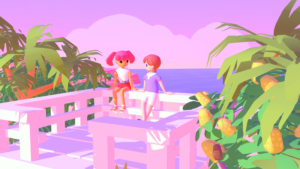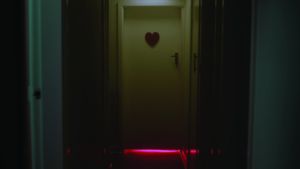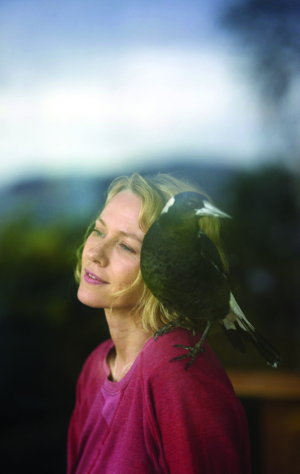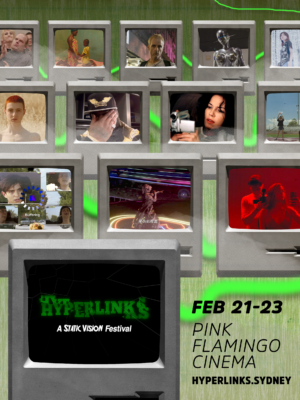It is over 25 years since the first issue of Cantrill’s Filmnotes was released in March 1971. The first roneoed issue has Marcel Duchamp’s Anemic Cinema on the front cover and Expanded Cinema (at the Age Gallery) on the back, with five pages of manifesto-like material in between and finished off with the hand written invocation: ‘Support the Alternate Cinema!’ This graffitist gesture appears like an emblem, an unofficial landmark in the history of cinema, written on a wall somewhere in the Naked City. It is a petition that has permeated each subsequent issue of Cantrill’s Filmnotes as it has moved to high quality print and colour photographs – visual documentation has always been high on the list.
Filmnotes survives into the pragmatic ’90s as a simulation of a scene in a culture of indifference where survival is the raison d’etre and where a wall-scrawled slogan is more likely to be perceived as an empty threat than any call to join the cause. It remains a hard slog as Corinne Cantrill, especially, has been relentlessly telling us whenever we ring up the Cantrills, or when we have the latest issue thrust towards us at some screening or film event.
Yet Filmnotes remains the most visible and sustained gesture to, for and about an Australian experimental (aka avant-garde, artist-based, personal) film culture. And it has a history. This is very important in the time of speed when History is supposed to be dead. These conditions have allowed a colonial mind-set to reassert itself in the film community. Disempowering raves about progress and nostalgia drown out notions of working with memory as a living and changing entity. The failure to emphasise the importance of self-expression has led to a diminution of ‘hope’.
There is a certain ambiguous tension in Filmnotes’ dual focus on both the regional and international. I find the following comments by Martin Rumsby[1]Martin Rumsby is a New Zealand artist curator who in the late ’80s and early ’90s travelled through North America with his Invisible Cinema program, on what he calls a ‘regional internationalism’, an accurate identification of the place from which Filmnotes carries out this brief. It also reveals the context in which Australian work can be received as relevant elsewhere, or outside of the spectacle.
There were these bands playing and there were our Super 8 movies, and the NZ Film Commission said, ‘this is regional stuff, it’s rubbish, it’s local and an aberration,’ and I come here (North America), and I go to these communities. I go to Toronto: they had this level of bands, and they had this level of film, in 16 and Super 8 … and in Seattle they had this sort of music that was the same. And Emily Carr in British Columbia and Georgia O’Keefe and Rita Angus in New Zealand were all the same – women regionalist artists and they were all dismissed as regionalists. There’s two internationalisms: there’s that Internationalism of the modernist history and the so-called Internationalists, but there’s also a Regional-Internationalism.[2]Martin Rumsby, unpublished interview conducted with Dirk de Bruyn at the 1994 Ann Arbor International Film Festival, Michigan.
It is the effect of supporting the alternate local Australian/New Zealand dissenters, dabblers, visitors and outsiders, and placing that within a regional internationalist dialogue that is Filmnotes’ most crucial and unique impact, one that can grow even further as an idea of History re-emerges and the idea of ‘many centres’ strengthens in cultural debates.
The Cell
Despite the scope and depth of alternative work that Filmnotes has documented over the decades, here in Australia there lingers a colonial short-sightedness, a cringe and self-doubt that turns us away from our own inventions. It is here that Filmnotes has inserted itself, as some sort of cell of self-assertion within a desert of indifference. This is the kind of strategy that has led to some fruitful lines of creativity for others as well. The Melbourne Super 8 Film Group, Arf Arf and RetArded Eye are all good current examples of independent, self-sufficient structures of artistic investigation which produce work of complexity and subtlety that the Australian condition is not generally able to cough up. It comes from an ability and intensity to turn inward with others and get into an interactive dialogue, which a larger arts community concerned with careerism and funding remains indifferent to. Like with the soft and malleable mollusc that builds its own hard outer shell, it is a strategy that can exact its own price, like the rigid need of the Melbourne Super 8 Film Group to focus on the Super 8 gauge above all else, or the strong editorial control that Corinne and Arthur impose on Filmnotes. It is their baby.
There is something quixotic about the whole exercise and something of a beachhead mentality that is often found at some new unresponsive ‘outpost’. It is as though Filmnotes is situated at the cusp between exploration and settlement, between an exploration of the medium and a need to document this work, between the need of doing and seeing for the first time, and of finding a place for these investigations to rest, to find a home. Quite a resonant adventure in a nation that is only as old as cinema itself. It is similarly concerned with settling an identity that is somehow isolated from the pack.
It is like:
Here is Robinson Crusoe doing what he does best, labouring day in, day out, repeating his clumsy persistent craftsmanship until it is almost ritualised, a psychic wall against loneliness.[3]Paul Zweig, The Adventurer, Basic Books, 1974, p. 116.
Of course what appears clumsy from the outside is not so on the inside. It is an assertion of self and difference that the environment, the landscape, fails to recognise of its own accord and really comes out of a dialogue with it. It is also a rejection of the tools and material that have built the master’s house for something more permanent and grounded in our own milieu, more about ourselves. It is significant that a large part of Filmnotes, despite the ‘control’ flagged earlier, is thus about letting the artists speak for themselves. This is the soft and open centre, the dialogue that occurs within its walls, and that was part of the initial impetus to get the publication going.

Negativism
The Cantrills have identified the late ’60s and early ’70s, when the foundations for an Australian film industry were being laid, as a time of growing negativism about avant-garde film. There were also no records or program notes made for screenings, even of the The Age Gallery event. It was this absence and developing negative climate that motivated Corinne and Arthur to open up a space where there would not be an authoritarian rant passing opinion on others, but a place where artists could speak with their own voice.
In Harry Hooton (as in Earth Message and the other shorter films screened with it), I can find no reason why any particular shot should come just where it does, and not twenty minutes earlier or later, if you re-shuffled the lot it could make no important difference. This is anti-cinema.[4]Sylvia Lawson, Harry Hooton, in Nation, 3 October 1970, p. 21.
Such comments as Sylvia Lawson’s seem to verify this negativism. I recently revisited through the all-gauge Sunday night screenings at the Cafe Bohemio[5]Inspired, in some ways, by the ritual screenings Corinne and Arthur used to hold in their home regularly on Sunday evenings. what I consider similar epiphanies, viewing the earlier mentioned Anemic Cinema and Man Ray’s Emak Bakia, the subversive practices of short Super 8 films by Pete Spence, Tony Woods, Marcus Bergner and Steven Ball, as well as the Cantrills’ own work, where there is a sense that the order of presentation has a random or interchangeable quality. Unlike Lawson circa 1970, I view this experience as a liberating one that opens up the work to multiple readings and juxtapositions, subverting as it does the linearity of the medium and increasing the importance of my role as an active viewer.
I might do well to add that we now find another negativism rising out of the new digital media domain, one about the irrelevance of experimental film. Yet these qualities of repetition, interchangeability and multiple- and open-reading are central to the making of engaging and successful interactive CD-Roms. These strategies have been rigorously documented by the Cantrills. It is also distressing that the National Library Film Collection, which Filmnotes has often championed, where so many innovative and important ideas in film central to an understanding of interactivity are kept, is being downgraded and is under threat of being dissipated. An economic rationalism coupled to a kind of cultural myopia threatens to be the writing on the wall for our film history. The need for the independent bent of Cantrill’s Filmnotes remains undiminished and necessary.
Real Work
There is also this other writing on the wall: that as a nation we are again being wrapped in a new colonialism whose dimensions include a more explicit colonisation of personal and intimate space. It is what Neil Postman means when he talks about the age of show business amusing us to death.[6]Neil Postman, Amusing Ourselves to Death, Penguin, 1985. This colonisation of self through technology is a close and inbred cousin of that mind-set that Filmnotes was invented to counter. This is why, as funding options in the arts are rolled back from grassroots activity, it remains a necessary voice. Despite its sometime similarity to an elitist ‘House on the Hill’ – the family business with a tinge of feudalism attached to it – Filmnotes offers something intangible that no amount of institutional careerist support has been able to deliver. I believe this something can be taken further in the next 25 years. It needs to include a greater contextualization and a greater critique of the work it covers, to place it more emphatically in relation to other cultural activity. The alternative is even greater isolation – for everyone.
I finish with a David Bromfield caution that speaks to Rumsby’s ‘regional internationalism’ and the ‘real work’, the often marginalised work, of the Cantrills’ project:
Unless something can be done quickly, we can look forward to a homogenised Australian visual culture as impoverished as it is authoritarian. The pressure to abolish genuine regional differences and usages in the visual arts and replace them with a commodified regionalism is enormous. Should it succeed Australia will be totally transparent to international art practices and the possibility of any Australian art will disappear. The real work in contemporary art will be done in new versions of bohemia by those artists who make a conscious effort not to address this new official culture and decide, instead, to struggle for differences and identity through their art and their immediate audience.[7]David Bromfield, Gone West: Essays and Criticism, 1981-92, p. 55.
Endnotes
| 1 | Martin Rumsby is a New Zealand artist curator who in the late ’80s and early ’90s travelled through North America with his Invisible Cinema program |
|---|---|
| 2 | Martin Rumsby, unpublished interview conducted with Dirk de Bruyn at the 1994 Ann Arbor International Film Festival, Michigan. |
| 3 | Paul Zweig, The Adventurer, Basic Books, 1974, p. 116. |
| 4 | Sylvia Lawson, Harry Hooton, in Nation, 3 October 1970, p. 21. |
| 5 | Inspired, in some ways, by the ritual screenings Corinne and Arthur used to hold in their home regularly on Sunday evenings. |
| 6 | Neil Postman, Amusing Ourselves to Death, Penguin, 1985. |
| 7 | David Bromfield, Gone West: Essays and Criticism, 1981-92, p. 55. |





